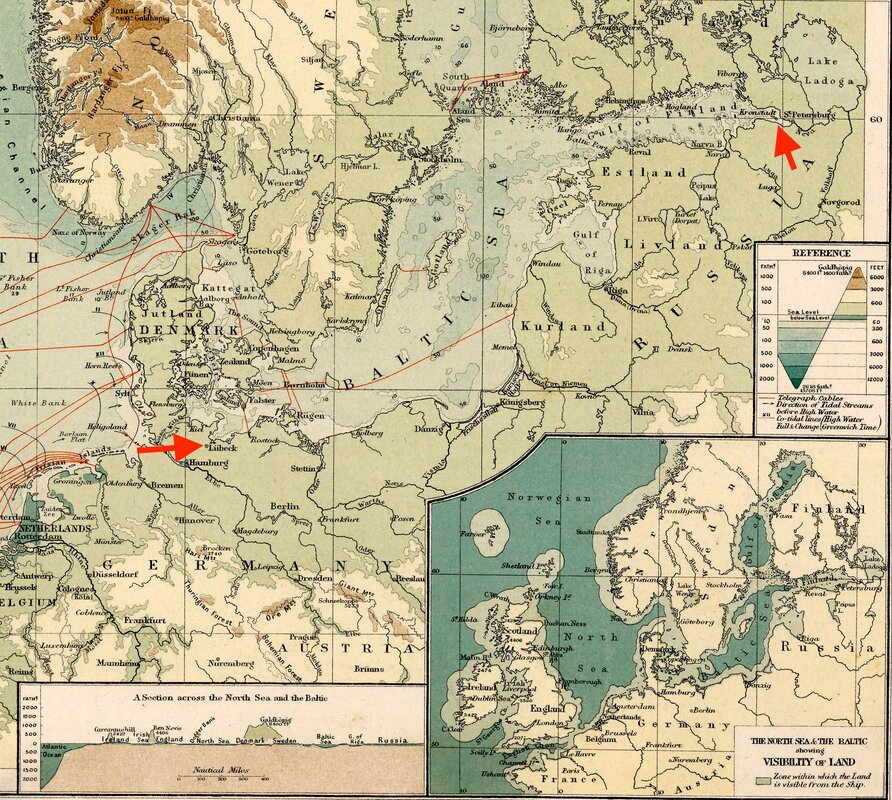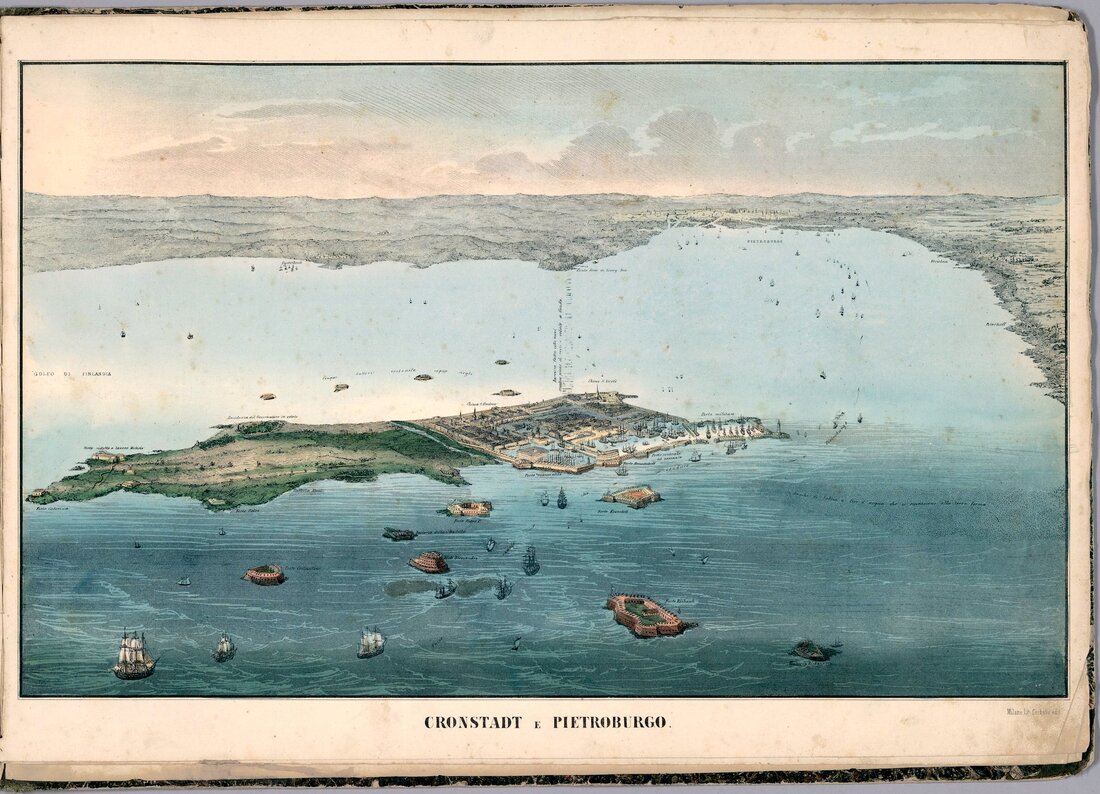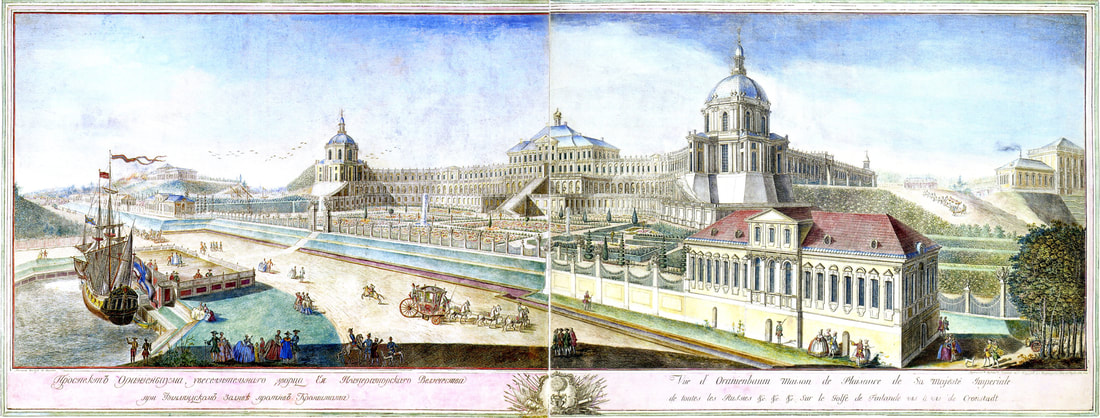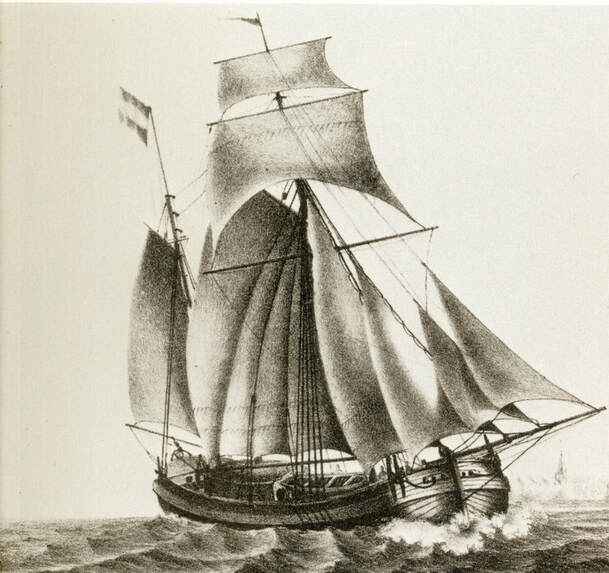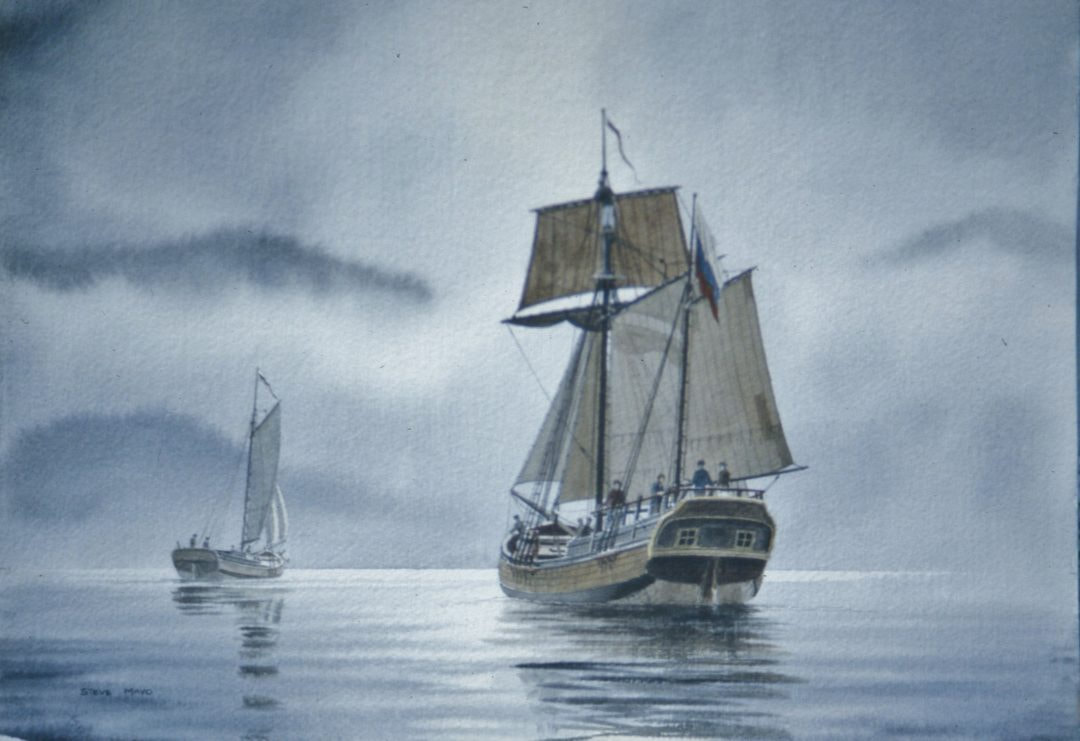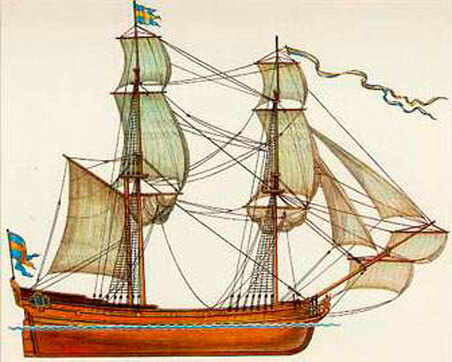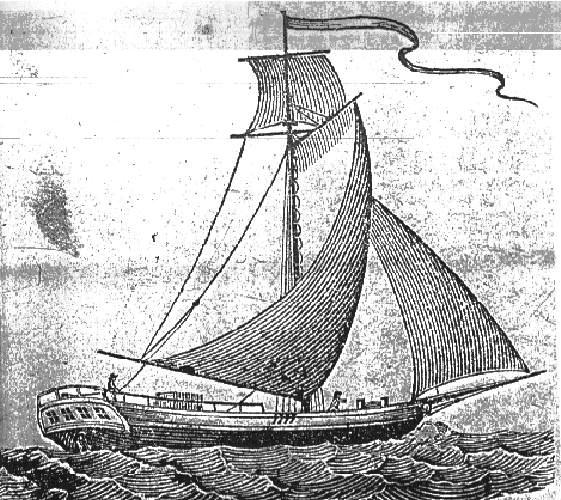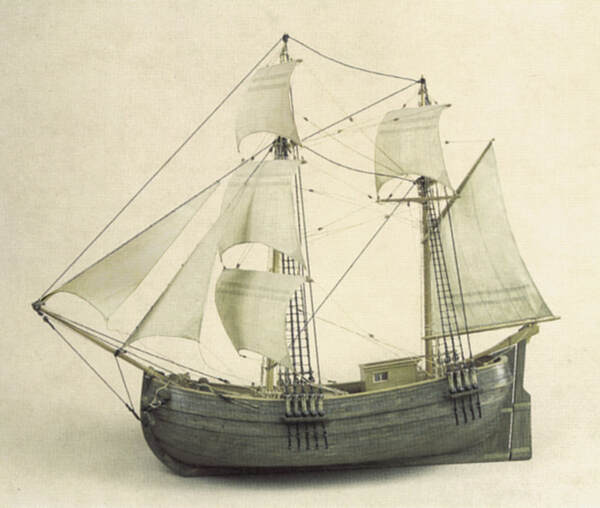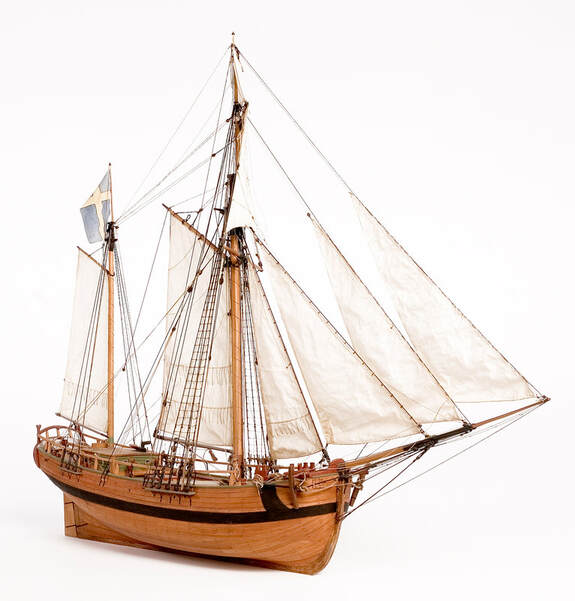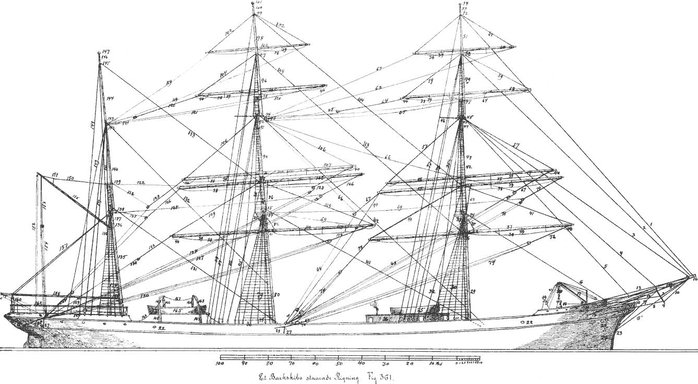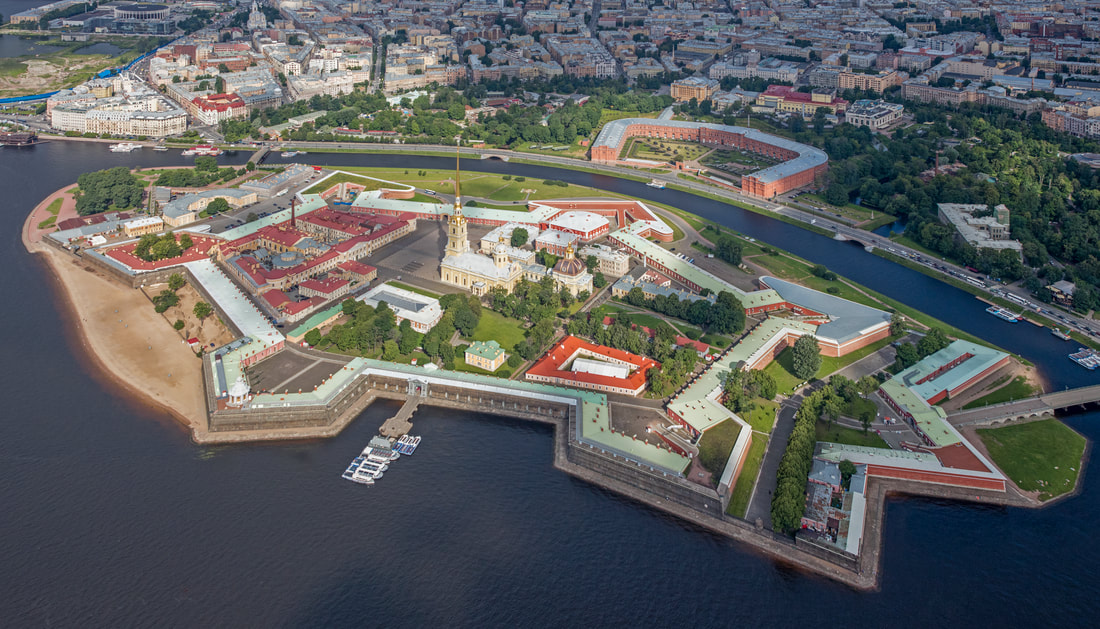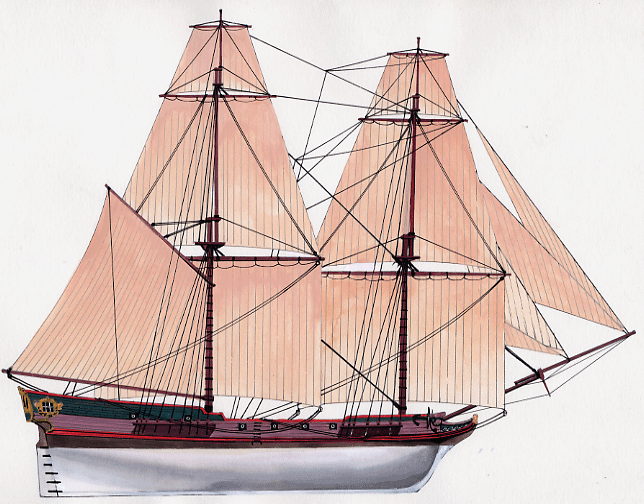History > Ship Transport to Kronstadt, Russia in 1766
Ship Transport to Kronstadt, Russia in 1766
In the spring and early summer of 1766, the colonists were formed into transport groups at the recruiting centers such as Büdingen. From there, they traveled to the old Hanseatic port of Lübeck, where they prepared for a sea voyage across the Baltic Sea and the Gulf of Finland to their new homeland in Russia. Lübeck was at the heart of the old Hanseatic League (Hansa), organized there in 1159. The Hansa served as a commercial and defensive confederation of merchant guilds and market towns in Northwestern and Central Europe. Sailing from Lübeck, the first point of arrival in Russia was the island fortress at Kronstadt, which stood in defense of the capital city of Saint Petersburg. Ironically, Kronstadt is a German word meaning Crown City.
The first colonist ship, Der Kleine Andreas, arrived at Kronstadt on April 29th. The last ship, the Vologda, arrived on October 15th. A complete chronology of ship arrivals at Kronstadt is provided in the book Auswanderung deutsche Kolonisten nach Russland im Jahre 1766 by Andreas Idt and Georg Rauschenbach (2019).
The Russian government initially planned to hire all transport ships through Lübeck merchants. However, due to the strong response to Catherine's Manifesto, several Russian ships and two large English ships (the George and the Love and Unity) were also employed to carry colonists from Lübeck to Kronstadt. The two English ships carried about 20 percent of the colonists in 1766. These were merchant ships built primarily to carry cargo, not people. The voyage from Lübeck to Kronstadt ranged from two weeks to over a month, depending on weather and other factors. Russian Admiralty documents show that some transport ships made an intermediate stop at either the city of Reval (now Tallinn, Estonia) or the city of Danzig (now Gdańsk, Poland). Five ships sailed from Lübeck to Reval in the spring of 1766. A small group of colonists (about 270) stayed in Reval and later founded the German colonies near Jamburg, outside St. Petersburg. Ninety ships arrived in Kronstadt within six months, from April 29 to October 15, 1766. These ships carried nearly 24,000 people to their new homeland.
Based on the book Chronicle of Wrecks and Fires of Ships of the Russian Fleet 1713-1853, not a single Russian ship carrying colonists to Russia was wrecked during the sea journeys to Kronstadt in 1766. The two English ships likewise had no incidents during the transport of colonists.
The Russian government initially planned to hire all transport ships through Lübeck merchants. However, due to the strong response to Catherine's Manifesto, several Russian ships and two large English ships (the George and the Love and Unity) were also employed to carry colonists from Lübeck to Kronstadt. The two English ships carried about 20 percent of the colonists in 1766. These were merchant ships built primarily to carry cargo, not people. The voyage from Lübeck to Kronstadt ranged from two weeks to over a month, depending on weather and other factors. Russian Admiralty documents show that some transport ships made an intermediate stop at either the city of Reval (now Tallinn, Estonia) or the city of Danzig (now Gdańsk, Poland). Five ships sailed from Lübeck to Reval in the spring of 1766. A small group of colonists (about 270) stayed in Reval and later founded the German colonies near Jamburg, outside St. Petersburg. Ninety ships arrived in Kronstadt within six months, from April 29 to October 15, 1766. These ships carried nearly 24,000 people to their new homeland.
Based on the book Chronicle of Wrecks and Fires of Ships of the Russian Fleet 1713-1853, not a single Russian ship carrying colonists to Russia was wrecked during the sea journeys to Kronstadt in 1766. The two English ships likewise had no incidents during the transport of colonists.
On the island of Kronstadt, documents were reviewed, and customs inspections were carried out. Under Article 6 of Catharine's Manifest of 1763, colonists had to pay customs duties on goods valued at more than 300 rubles per family intended to be sold in Russia. Most of the colonists had only modest personal belongings and nothing to declare. However, some colonists arrived with fabrics, tobacco, stockings, scarves, and women's jewelry, which required the payment of duties.
When the immigration processing was complete, the colonists were ferried about 4 miles to Oranienbaum (now Lomonosov) on the mainland by six-oared boats manned by Russian sailors. Oranienbaum was home to an Imperial Grand Palace where Catherine the Great spent some holidays. The name Oranienbaum is the German word for Orange Tree. Stories are told that Catherine greeted groups of colonists in their native tongue from the balcony of her palace.
When the immigration processing was complete, the colonists were ferried about 4 miles to Oranienbaum (now Lomonosov) on the mainland by six-oared boats manned by Russian sailors. Oranienbaum was home to an Imperial Grand Palace where Catherine the Great spent some holidays. The name Oranienbaum is the German word for Orange Tree. Stories are told that Catherine greeted groups of colonists in their native tongue from the balcony of her palace.
Once on the mainland, the colonists were recorded on lists made under the supervision of Johann (Ivan) Kulberg, the Titular Counselor and Translator for the Office for the Guardianship of Foreign Settlers. Kulberg was assisted by Johann Brasche and Konrad Schmahl. The colonist ship arrival documents are known as the "Kulberg Lists."
Temporary quarters for the new arrivals were provided in former military barracks at Oranienbaum. The colonists typically spent several weeks preparing for the next segment of their journey to the settlement area on the lower Volga.
The table below lists 26 ships carrying colonists who founded the colony of Norka in August and September of 1767. The vast majority of the colonists that settled in Norka were aboard the Novaya Dvinka, Slon (Elephant), and Fortitudo, which all arrived in Kronstadt on July 19, 1766, and the Vologda, Strelna, and Apollo, which arrived on July 28th and 29th, 1766.
Temporary quarters for the new arrivals were provided in former military barracks at Oranienbaum. The colonists typically spent several weeks preparing for the next segment of their journey to the settlement area on the lower Volga.
The table below lists 26 ships carrying colonists who founded the colony of Norka in August and September of 1767. The vast majority of the colonists that settled in Norka were aboard the Novaya Dvinka, Slon (Elephant), and Fortitudo, which all arrived in Kronstadt on July 19, 1766, and the Vologda, Strelna, and Apollo, which arrived on July 28th and 29th, 1766.
Arrival Date (Julian Calendar) |
Ship Name (Translation) |
Ship Type |
Ship Commander |
Total Colonists Aboard |
Kulberg Document Nos. |
No./90 |
31-May-1766 |
Die Vergoldete Weintraube (The Gilded Grape) |
Joachim Hermann Andersen |
255 |
761-832 |
9 |
|
9-Jun-1766 |
Love and Unity |
Kat |
Thomas Fairfax |
971/981 |
1600-1857 |
13 |
23-Jun-1766 |
Ne Tron Men (Don't Touch Me) |
Emelyan Lozhnikov |
47 |
2238-2253 |
26 |
|
17-Jul-1766 |
Lev |
Fyodor Fyodorov |
417 |
2315-2442 |
27 |
|
19-Jul-1766 |
Concordia |
Galliot |
Jacob Bauert |
298/277 |
2580-2679 |
31 |
19-Jul-1766 |
Novaya Dvinka |
Pink |
Ivan Perepechin |
308/283 |
3803-3895 |
36 |
19-Jul-1766 |
Kargopol (Cargo) |
Pink |
Moses Davydov |
300/284 |
4116-4209 |
37 |
19-Jul-1766 |
Kronverk |
Galliot |
Dimitriy Ilyin |
170/176 |
2714-2765 |
38 |
19-Jul-1766 |
Slon (Elephant) |
Pink |
Sergey Panov |
398 |
3995-4115 |
39 |
19-Jul-1766 |
Kronstadt |
Galliot |
Samuel Gibbs |
204 |
2841-2907 |
41 |
19-Jul-1766 |
Fortitudo (Fortitude) |
John Scott |
711/704 |
3600-3802 |
46 |
|
19-Jul-1766 |
Christina |
Shnyava |
Jacob Stappenberg |
485 |
3078-3254 |
47 |
21-Jul-1766 |
Alette |
Wybe Hendricks |
326/325 |
3505-3599 |
50 |
|
22-Jul-1766 |
Der Ringerende Jacob (The Wrestler Jacob) |
Johann Heitmann |
232/228 |
4089-4156 |
53 |
|
28-Jul-1766 |
Vologda |
Pink |
Sergey Bartenyev |
277 |
4836-4924 |
55 |
28-Jul-1766 |
Strelna |
Galliot |
Login Vasiley Sornev |
203 |
4925-5005 |
56 |
29-Jul-1766 |
Apollo |
? |
Friedrich Detleff Mörenberg |
704 |
5006-5213 |
57 |
2-Aug-1766 |
Love and Unity |
Kat |
Thomas Fairfax |
963 |
5273-5573 |
58 |
11-Aug-1766 |
Cyrus John |
Packet boat |
Gabriel Poddubsky |
46 |
5574-5588 |
60 |
11-Aug-1766 |
Citadel |
Galliot |
Grigory Bukharin |
182/183 |
5214-5272 |
61 |
14-Aug-1766 |
Die Jungfer Frederika (The Maiden Frederika) |
Hans Christian Korsholm |
255/256 |
5681-5763 |
62 |
|
15-Aug-1766 |
Diana |
Galliot |
Marcus Draguhn |
255/256 |
5589-5680 |
63 |
16-Aug-1766 |
Die Frau Diederika (Mrs Diederika) |
Galliot |
Johann Joachim Luna |
295/304 |
6043-6130 |
65 |
18-Aug-1766 |
Catharina Eleonora |
Galliot |
Peter Rehder |
544 |
6398-6547 |
72 |
22-Aug-1766 |
Eva Maria |
Galliot |
Franz Christopher Schröder |
403 |
6796-6942 |
74 |
26-Aug-1766 |
Die Jäger (The Hunter) |
Shnyava |
Gabriel Will |
295 |
6779-6795 6943-7032 |
76 |
Notes:
1. The data in the table above was extracted and translated from the book Auswanderung deutsche Kolonisten nach Russland im Jahre 1766 (Second edition-2019). The arrival dates, some ship and commander names differ from the book List of Colonists to Russia in 1766 by Igor Pleve. In many cases, previously missing ship and commander names have been discovered. In some cases, reports vary regarding the number of colonists aboard each ship. This table lists each reported number. The far right column indicates the arrival order based on the 90 ships disembarking colonists at Kronstadt in 1766. This new information is based upon recently discovered archival documents and is considered the most accurate.
2. Not all colonists listed in the 1767 census of Norka have been found in the Kulberg Lists from 1766. The estimated numbers of Norka colonists listed in the ship descriptions below will be updated when these "missing" colonists are documented in the Kulberg Lists.
1. The data in the table above was extracted and translated from the book Auswanderung deutsche Kolonisten nach Russland im Jahre 1766 (Second edition-2019). The arrival dates, some ship and commander names differ from the book List of Colonists to Russia in 1766 by Igor Pleve. In many cases, previously missing ship and commander names have been discovered. In some cases, reports vary regarding the number of colonists aboard each ship. This table lists each reported number. The far right column indicates the arrival order based on the 90 ships disembarking colonists at Kronstadt in 1766. This new information is based upon recently discovered archival documents and is considered the most accurate.
2. Not all colonists listed in the 1767 census of Norka have been found in the Kulberg Lists from 1766. The estimated numbers of Norka colonists listed in the ship descriptions below will be updated when these "missing" colonists are documented in the Kulberg Lists.
Additional information about each ship's arrival is presented below in alphabetical order:
Alette
The Alette arrived in Kronstadt on July 21, 1766, under the command of Wybe Hendricks. The ship was categorized as a koff and carried about 325 colonists. Alette is a girl's name of Greek and Latin origin, meaning "footloose" or "small-winged one."
The only Norka family aboard this ship was the household of Friedrich Jäger, a public colonist from the Pfalz (Palatinate) region. Friederich died en route to the settlement area. His wife, Anna Elisabeth, and two children (Wilhelm and Johann Peter) arrived in Norka on August 15, 1767.
The only Norka family aboard this ship was the household of Friedrich Jäger, a public colonist from the Pfalz (Palatinate) region. Friederich died en route to the settlement area. His wife, Anna Elisabeth, and two children (Wilhelm and Johann Peter) arrived in Norka on August 15, 1767.
Apollo
The Apollo arrived in Kronstadt on July 29, 1766, carrying 704 total colonists. The Apollo was commanded by Friedrich Detleff Mörenberg. Unfortunately, records do not indicate the type of ship. Given the number of colonists aboard, it may have been a barque similar to the Fortitudo.
About 95 passengers on this ship arrival were members of households that later settled in Norka.
About 95 passengers on this ship arrival were members of households that later settled in Norka.
Catharina Eleonora
The Catharina Eleonora arrived at Kronstadt on August 18, 1766, under the command of Peter Rehder. The galliot carried 544 colonists. A galliot was a type of Dutch or German merchant ship of 20 to 400 tons (bm), similar to a ketch, with a rounded fore and aft like a fluyt. Galliots had nearly flat bottoms to sail in shallow waters. These ships were especially favored for coastal navigation in the North and Baltic seas. The galliot was the most common type of ship carrying colonists who later settled in Norka.
About 20 public colonists aboard this ship were members of families that settled in Norka.
About 20 public colonists aboard this ship were members of families that settled in Norka.
Christina
The Christina arrived at Kronstadt on July 19, 1766, under the command of Jacob Stappenberg, with 485 colonists onboard. The ship is categorized as a shnyava (English: snow, German: schnau, or Dutch: snauw), a small sailing merchant or military vessel distributed from the second half of the XVII century to the end of the XIX century in northern Europe and Russia. A schnyava had two masts with straight sails, a bushprit, a stackel, and a clover. The average displacement of a schnyava was about 150 tons, with a length of 80-100 feet and a width of 20 to 26 feet.
About 15 people who settled in Norka were aboard this ship.
About 15 people who settled in Norka were aboard this ship.
Citadel
The Russian galliot Citadel arrived at Kronstadt on July 29, 1766. Philipp Bollender, his wife Anna Margaretha, and their three children, Johann Georg, Johannes, and Magdalena, were aboard this ship. Only Johannes, age 8, survived the year-long journey to Norka, where he lived with Heinrich and Anna Maria Albrecht in 1767.
The Citadel was commanded by Grigory Ivanovich Bukharin. Bukharin was born on January 27, 1743. He graduated from The Naval Nobility Cadet Corps (1760-1764). From 1761 to 1765, he participated in annual campaigns on the Baltic Sea. Bukharin later fought in the Russian-Turkish War of 1768-1774. In 1783, Bukharin became Captain of the 1st rank and, in 1789, received the rank of captain of the Major-General. He was awarded the Order of St. Vladimir of the 3rd degree in 1790. After a remarkable military career, Bukharin died in 1796. Bukharin is an example of the high-level Russian naval officers transporting the colonists. These officers all spoke German after receiving training in the cadet corps. As a result, they could communicate with the colonists in their own language.
The Citadel was commanded by Grigory Ivanovich Bukharin. Bukharin was born on January 27, 1743. He graduated from The Naval Nobility Cadet Corps (1760-1764). From 1761 to 1765, he participated in annual campaigns on the Baltic Sea. Bukharin later fought in the Russian-Turkish War of 1768-1774. In 1783, Bukharin became Captain of the 1st rank and, in 1789, received the rank of captain of the Major-General. He was awarded the Order of St. Vladimir of the 3rd degree in 1790. After a remarkable military career, Bukharin died in 1796. Bukharin is an example of the high-level Russian naval officers transporting the colonists. These officers all spoke German after receiving training in the cadet corps. As a result, they could communicate with the colonists in their own language.
Concordia
The Concordia arrived at Kronstadt on July 19, 1766, under the command of Jacob Bauert. The galliot carried between 277 and 298 colonists.
The only known Norka colonists on this ship were the Johannes Jacoby family from Isenburg. Johannes, a miller, did not survive the journey, but his wife Susanna and sons Philipp, Johann, and Johannes arrived in Norka on August 15, 1767.
The only known Norka colonists on this ship were the Johannes Jacoby family from Isenburg. Johannes, a miller, did not survive the journey, but his wife Susanna and sons Philipp, Johann, and Johannes arrived in Norka on August 15, 1767.
Cyrus John
The packet boat Cyrus John, commanded by Gabriel Poddubsky, arrived at Kronstadt on August 11, 1766, carrying 46 colonists.
Johann Conrad and Anna Maria Heffenider, were aboard this ship. They safely arrived in Norka on August 26, 1767.
Johann Conrad and Anna Maria Heffenider, were aboard this ship. They safely arrived in Norka on August 26, 1767.
Diana
Under the command of Marcus Draguhn, the galliot Diana arrived at Kronstadt on August 16, 1766, carrying about 255 colonists. Only one Norka settler, Johann Just Döring, a single Lutheran shoemaker from Stolberg, was aboard this ship. By the time of the Norka census in late 1767, Johann Just was married to Anna Margaretha (surname unknown).
Die Frau Diederika
On August 16, 1766, the galliot Die Frau Diederika (Mrs. Diederika) arrived at Kronstadt under the command of Johann Joachim Luna. The ship carried between 295 and 304 colonists.
Aboard this ship were members of the Wilhelm Köhler family that would later settle in Norka. Wilhelm's wife, Anna Maria, and son, Conrad, died en route to the settlement area. It is unknown if his daughter Catharina, age 20, survived or also died en route.
Aboard this ship were members of the Wilhelm Köhler family that would later settle in Norka. Wilhelm's wife, Anna Maria, and son, Conrad, died en route to the settlement area. It is unknown if his daughter Catharina, age 20, survived or also died en route.
Die Jäger
One of the larger ships carrying 295 colonists, Die Jäger (The Hunter), was commanded by Gabriel Will. The ship is listed as a shnyava (English: Snow, German: Schnau), a small sailing merchant or military vessel distributed from the second half of the XVII century to the end of the XIX century in northern Europe and Russia. The shnyavas had two masts with straight sails and a bushprit, a stackel and a clover. The average displacement of the schnyava was about 150 tons, with a length of 25-30 meters and a width of 6-8 meters.
The only Norka family known to be aboard this ship was Margaretha Schäfer, a widow from Isenburg, and her two sons, Johann Heinrich and Johannes, aged 10 1/2 and 2. Margaretha was recruited by the privateer Beauregard. Her younger son, Johannes, died before arriving at Norka.
The only Norka family known to be aboard this ship was Margaretha Schäfer, a widow from Isenburg, and her two sons, Johann Heinrich and Johannes, aged 10 1/2 and 2. Margaretha was recruited by the privateer Beauregard. Her younger son, Johannes, died before arriving at Norka.
Die Jungfer Frederika
Under the command of Hans Christina Korsholm, Die Jungfer Frederika (The Maiden Frederika) arrived at Kronstadt on August 14, 1766. This vessel was a gukor, a type of fishing ship used in the 18th century. This voyage carried about 255 colonists.
Onboard this voyage was the Joseph Legue household (also Lechai, Letke, or Lütke), who were Catholics from Lille, Flanders (now Lille, France). All four family members survived the journey to Norka.
Onboard this voyage was the Joseph Legue household (also Lechai, Letke, or Lütke), who were Catholics from Lille, Flanders (now Lille, France). All four family members survived the journey to Norka.
Der Ringerende Jacob
On July 22, 1766, Der Ringerende Jacob (The Wrestler Jacob), commanded by Johann Heitmann, arrived at Kronstadt. The galleass carried between 228 and 232 colonists.
The Caspar Dietz family, Catholics from Pfalz (Palatinate), were aboard this ship. Both parents and two children died en route to the settlement area. Only six-year-old Susanna Dietz survived the journey. On August 15, 1767, Susanne arrived in Norka with Johannes and Magdalena Milling. The Millings arrived in Russia aboard the Vologda on July 28th.
The Caspar Dietz family, Catholics from Pfalz (Palatinate), were aboard this ship. Both parents and two children died en route to the settlement area. Only six-year-old Susanna Dietz survived the journey. On August 15, 1767, Susanne arrived in Norka with Johannes and Magdalena Milling. The Millings arrived in Russia aboard the Vologda on July 28th.
Die Vergoldete Weintraube
Die Vergoldete Weintraube (The Gilded Grape) arrived at Kronstadt on May 5, 1766. The galliot, commanded by Joachim Hermann Andersen, carried 255 colonists and was the first ship to deliver people who would later settle in Norka.
Onboard this ship were Friedrich and Catharina Haller, Catholics from Mainz. Both survived the journey to Norka.
Onboard this ship were Friedrich and Catharina Haller, Catholics from Mainz. Both survived the journey to Norka.
Eva Maria
The Eva Maria arrived at Kronstadt on August 22, 1766, under the command of Franz Christian Schröder. The galliot carried 403 colonists to Russia.
The Peter Klaus family was aboard this ship. They were part of a private recruiter group. Peter and his wife, Elisabeth, arrived in Norka on September 22, 1767. Their two children, Anton and Johannes, died en route to the settlement area.
The Peter Klaus family was aboard this ship. They were part of a private recruiter group. Peter and his wife, Elisabeth, arrived in Norka on September 22, 1767. Their two children, Anton and Johannes, died en route to the settlement area.
Fortitudo
The Fortitudo (Fortitude) was a barque under the command of John Scott. The ship arrived at Kronstadt on July 19, 1766, carrying over 700 passengers. About 170 people who were members of households that later settled in Norka were aboard this arrival.
Kargopol
The Russian pink Kargopol (Cargo) arrived at Kronstadt under the command of Moses Davydov on July 19, 1766. The ship carried between 284 and 300 colonists.
About 17 colonists who were members of families that settled in Norka were onboard, including members of the Lauterbach, Preisendorf, Werth, Hartung, and Frank families.
About 17 colonists who were members of families that settled in Norka were onboard, including members of the Lauterbach, Preisendorf, Werth, Hartung, and Frank families.
Kronstadt
Commanded by Samuel Gibbs, the galliot Kronstadt arrived at its namesake island of Kronstadt on July 19, 1766, carrying 204 colonists.
The Martin Trüber family was aboard this ship. Martin and his wife Ann died en route to Norka. His son Nicolaus, age 17, and daughter Anna, age 13, arrived in Norka on August 15, 1767, with Conrad and Elisabeth Müller. Conrad was the Vorsteher of the colony at the time of the 1767 census.
The Martin Trüber family was aboard this ship. Martin and his wife Ann died en route to Norka. His son Nicolaus, age 17, and daughter Anna, age 13, arrived in Norka on August 15, 1767, with Conrad and Elisabeth Müller. Conrad was the Vorsteher of the colony at the time of the 1767 census.
Kronverk
The Kronverk arrived at Kronstadt on July 19, 1766, under the command of Dimitriy Ilyin. The galliot carried between 170 and 176 colonists. Of those, about 18 were with families that settled in Norka.
The ship's name is derived from the German word "kronwerk," which means crown-shaped fortification. An example of a kronverk can be seen at the Peter and Paul Fortress in St. Petersburg. The colonists sailed past this fortress en route to the settlement area.
The ship's name is derived from the German word "kronwerk," which means crown-shaped fortification. An example of a kronverk can be seen at the Peter and Paul Fortress in St. Petersburg. The colonists sailed past this fortress en route to the settlement area.
Love and Unity
The Love and Unity was an English merchant ship hired to help handle more than-expected colonists in 1766. It was commanded by Thomas Fairfax. The ship type was listed as a kat. A second English ship, the barque George, was also hired. It was under the command of Adam Bairnsfair. Both English ships sailed from Newcastle and arrived in Lübeck on April 20th to prepare for their first transport of colonists. Each ship could carry about 1,000 colonists. Both ships made two passages during the summer of 1766 and carried about 20 percent of the colonists that year. The arrival dates at Kronstadt were June 9, 1766, and August 2, 1766.
Two Norka colonists, Johann Heinrich Dinges and his wife, Maria Louisa, were aboard the June 9 arrival. One Norka colonist, Johannes Sauer, was aboard the August 2 arrival.
Two Norka colonists, Johann Heinrich Dinges and his wife, Maria Louisa, were aboard the June 9 arrival. One Norka colonist, Johannes Sauer, was aboard the August 2 arrival.
Lev
The pink Lev arrived at Kronstadt on July 17, 1766, with 417 colonists. The ship was commanded by Fyodor Fyodorov.
Eleven members of the Giebelhaus and Schönemann families were aboard this ship. All survived the journey to Norka.
Eleven members of the Giebelhaus and Schönemann families were aboard this ship. All survived the journey to Norka.
Ne Tron Men
The packet boat Ne Tron Men (Don't Touch Me) arrived at Kronstadt on June 23, 1766, under the command of Emelyan Lozhnikov, carrying 47 colonists.
The Louis Battin (Batt) family was aboard this ship. They were Catholics from Paris. Louis was a bookbinder. One son, Heinrich, died en route. Louis, his wife Susanna, and his daughter Anna survived and arrived in Norka on August 26, 1766.
The Louis Battin (Batt) family was aboard this ship. They were Catholics from Paris. Louis was a bookbinder. One son, Heinrich, died en route. Louis, his wife Susanna, and his daughter Anna survived and arrived in Norka on August 26, 1766.
Novaya Dvinka
The Novaya Dvinka was a Russian pink under the command of Ivan Perepechin. The ship arrived at Kronstadt on July 19, 1766, carrying between 283 and 308 colonists (sources differ on the exact number).
Approximately 20 people who were part of families that settled in Norka were aboard this ship.
Under Emperor Peter the Great, Arkhangelsk became a shipbuilding center. As a result, the ships built there were often named for settlements in that region. Arkhangelsk is located on the Severnaya Dvina River. Under Peter the Great, the fortress of Novo-Dvinka (New Dvinka) was built 15 kilometers from Arkhangelsk. The ship Novaya Dvinka was named in honor of this fortress.
Approximately 20 people who were part of families that settled in Norka were aboard this ship.
Under Emperor Peter the Great, Arkhangelsk became a shipbuilding center. As a result, the ships built there were often named for settlements in that region. Arkhangelsk is located on the Severnaya Dvina River. Under Peter the Great, the fortress of Novo-Dvinka (New Dvinka) was built 15 kilometers from Arkhangelsk. The ship Novaya Dvinka was named in honor of this fortress.
Slon (Elephant)
The Russian pink Slon (Elephant) arrived at Kronstadt on July 19, 1766, under the command of Midshipman Sergey Panov, carrying 398 colonists in total. Nearly 200 members of households that later settled in Norka were aboard this arrival. The Slon also arrived earlier in Kronstadt on May 27th and later on September 13th. No Norka colonists are known to be on the other voyages.
Construction on the Slon began on October 24, 1757, and it was launched on June 3, 1758. The ship was 130 feet long, 29 feet wide, and 12 feet, 6 inches deep. The ship carried 22 guns.
The attentive reader can vividly imagine how 398 colonists and crew were placed on this small ship during the several weeks of the voyage.
Construction on the Slon began on October 24, 1757, and it was launched on June 3, 1758. The ship was 130 feet long, 29 feet wide, and 12 feet, 6 inches deep. The ship carried 22 guns.
The attentive reader can vividly imagine how 398 colonists and crew were placed on this small ship during the several weeks of the voyage.
Strelna
The Russian galliot Strelna arrived at Kronstadt on July 28, 1766. The ship carried 203 colonists and a crew of about 20 people. Nearly 60 members of households that later settled in Norka were aboard this arrival. The Strelna was named for a city near St. Petersburg.
During the transport of the colonists in 1766, the Strelna was commanded by Midshipman Login Vasilyevich Sornev. Sornev was from a noble family in Smolensk Province, and his father was a corporal of the Roslavl Dragoon Squadron. In 1761, the family made their home at Roslavl and had 140 serfs working for them in various locations. Sornev graduated from the Naval Nobility Cadet Corps (NGCC) in St. Petersburg, which was established in Moscow in 1701. At the time, the NGCC was one of Russia's best military education institutions, training and commissioning highly educated officers for the Imperial Russian Navy. Cadets and Midshipmen (cadets who achieved the highest classification) studied mathematics, navigation, artillery, fortification, rigging, languages (Russian, French, English, German), geography, history, politics, genealogy, rhetoric, heraldry, morals, drawing, fencing, dancing. Sornev achieved the rank of Midshipman on April 5, 1761. The rank of Midshipman in the Russian Navy is the equivalent of a Lieutenant in the Russian Army. This is perhaps why Sornev and other ship commanders are labeled "Lieutenants." After his service transporting colonists, Sornev became a Lieutenant on March 3, 1769, a Lieutenant commander on January 1, 1773); and a Captain of the 2nd rank on January 1, 1779.
Sornev and the Strelna made a second voyage that arrived in Kronstadt on October 15, 1766, one of the last two ships to bring colonists to Russia.
Seven years after it had delivered a large group of colonists in Kronstadt, the Strelna ran aground, was broken, and sank on September 14, 1773, on Sommers Island, a rocky outcropping in the Eastern reach of the Gulf of Finland. Amazingly, 19 crew members and one young girl clung to the cabin's remains and survived the ordeal.
During the transport of the colonists in 1766, the Strelna was commanded by Midshipman Login Vasilyevich Sornev. Sornev was from a noble family in Smolensk Province, and his father was a corporal of the Roslavl Dragoon Squadron. In 1761, the family made their home at Roslavl and had 140 serfs working for them in various locations. Sornev graduated from the Naval Nobility Cadet Corps (NGCC) in St. Petersburg, which was established in Moscow in 1701. At the time, the NGCC was one of Russia's best military education institutions, training and commissioning highly educated officers for the Imperial Russian Navy. Cadets and Midshipmen (cadets who achieved the highest classification) studied mathematics, navigation, artillery, fortification, rigging, languages (Russian, French, English, German), geography, history, politics, genealogy, rhetoric, heraldry, morals, drawing, fencing, dancing. Sornev achieved the rank of Midshipman on April 5, 1761. The rank of Midshipman in the Russian Navy is the equivalent of a Lieutenant in the Russian Army. This is perhaps why Sornev and other ship commanders are labeled "Lieutenants." After his service transporting colonists, Sornev became a Lieutenant on March 3, 1769, a Lieutenant commander on January 1, 1773); and a Captain of the 2nd rank on January 1, 1779.
Sornev and the Strelna made a second voyage that arrived in Kronstadt on October 15, 1766, one of the last two ships to bring colonists to Russia.
Seven years after it had delivered a large group of colonists in Kronstadt, the Strelna ran aground, was broken, and sank on September 14, 1773, on Sommers Island, a rocky outcropping in the Eastern reach of the Gulf of Finland. Amazingly, 19 crew members and one young girl clung to the cabin's remains and survived the ordeal.
Vologda
The Vologda was a Russian pink under the command of Sergey Bartenyev. The ship arrived in Kronstadt on July 28, 1766, carrying 277 colonists, including over 50 people who were members of households that would later settle in Norka. The ship was named after the Russian city of Vologda. The Vologda made a second voyage that arrived on October 15, 1766, one of the last two ships to bring colonists to Russia under the provisions of Catherine's Manifesto. No colonists who settled in Norka were aboard the second voyage.
Sources
Chronicle of Wrecks and Fires of Ships of the Russian fleet 1713-1853. Publishing house of the printing house of the Imperial Academy of Sciences, Saint Petersburg. 1855. Translated to English by Alexander Schreiber.
General Sea List. V. Demanov Publishing House. St. Petersburg: 1885. Translated to English by Alexander Schreiber.
List of Russian military vessels from 1668 to 1860. Printing office of the Maritime Ministry in the Main Admiralty. St. Petersburg. 1872. Translated to English by Alexander Schreiber.
Pleve, I. R., and Richard R. Rye. The German Colonies on the Volga: The Second Half of the Eighteenth Century. Lincoln, Neb.: American Historical Society of Germans from Russia, 2001. Print.
Pleve, I. R. Lists of Colonists to Russia in 1766: Reports by Ivan Kulberg. Saratov, Russia: Saratov State Technical U, 2010. Print.
Idt, Andreas and Rauschenbach, Georg. Auswanderung deutsche Kolonisten nach Russland im Jahre 1766 (Second edition). Moscow: 2019.
Zolotarev V. A., Kozlov I. A. Three centuries of the Russian fleet. Publishing house "Polygon", St. Petersburg. 2002. Translated to English by Alexander Schreiber.
Feofanov, F. M. Naval Officers of the Russian Empire of the XVIII Century. Biographical dictionary. St. Tikhon's Orthodox University for the Humanities publishing house. Moscow: 2016. Translated to English by Alexander Schreiber.
Map showing the Jamburg colonies courtesy of Germans from Russian Settlement Locations created by Sandy Schilling Payne.
German Maritime Museum - Schiffsliste (ship list)
General Sea List. V. Demanov Publishing House. St. Petersburg: 1885. Translated to English by Alexander Schreiber.
List of Russian military vessels from 1668 to 1860. Printing office of the Maritime Ministry in the Main Admiralty. St. Petersburg. 1872. Translated to English by Alexander Schreiber.
Pleve, I. R., and Richard R. Rye. The German Colonies on the Volga: The Second Half of the Eighteenth Century. Lincoln, Neb.: American Historical Society of Germans from Russia, 2001. Print.
Pleve, I. R. Lists of Colonists to Russia in 1766: Reports by Ivan Kulberg. Saratov, Russia: Saratov State Technical U, 2010. Print.
Idt, Andreas and Rauschenbach, Georg. Auswanderung deutsche Kolonisten nach Russland im Jahre 1766 (Second edition). Moscow: 2019.
Zolotarev V. A., Kozlov I. A. Three centuries of the Russian fleet. Publishing house "Polygon", St. Petersburg. 2002. Translated to English by Alexander Schreiber.
Feofanov, F. M. Naval Officers of the Russian Empire of the XVIII Century. Biographical dictionary. St. Tikhon's Orthodox University for the Humanities publishing house. Moscow: 2016. Translated to English by Alexander Schreiber.
Map showing the Jamburg colonies courtesy of Germans from Russian Settlement Locations created by Sandy Schilling Payne.
German Maritime Museum - Schiffsliste (ship list)
Last updated December 8, 2023
